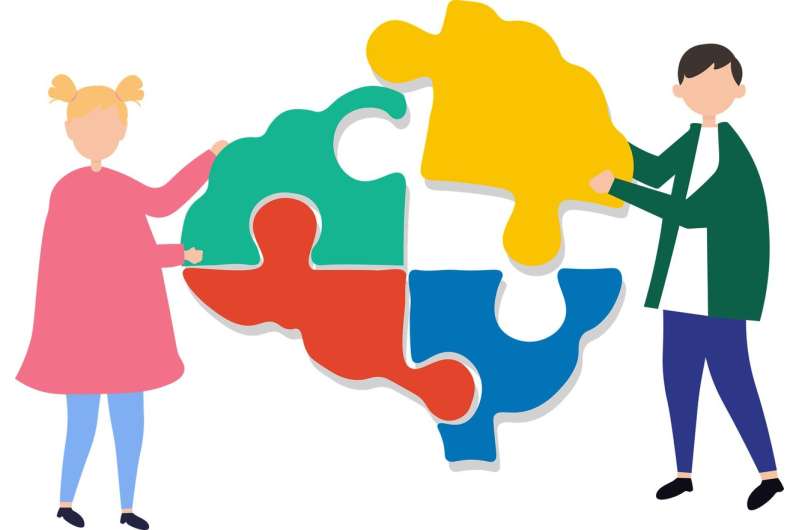This article has been reviewed according to Science X's editorial process and policies. Editors have highlighted the following attributes while ensuring the content's credibility:
fact-checked
trusted source
proofread
Rates of autism climb to new highs in the US, with California setting record numbers

New federal studies co-authored by autism experts at Rutgers found that more children have been diagnosed with autism than at any time since monitoring began more than two decades ago.
According to the U.S. Centers for Disease Control and Prevention (CDC), about 4% of 8-year-old boys and 1% of 8-year-old girls, have autism in the U.S. These estimates are the highest since the CDC's Autism and Developmental Disabilities Monitoring (ADDM) Network was created in 2000.
Biennial studies from the ADDM Network, which analyzed data from 2020, were coauthored by Walter Zahorodny, director of the New Jersey Autism Study at the Rutgers New Jersey Medical School and Josephine Shenouda, a Rutgers epidemiologist.
The first study, the CDC's 2020 autism prevalence report, found that California set new records, diagnosing 45% more boys with autism than any other state in the network. Nearly 7% of all 8-year-old boys in the San Diego region are estimated to have autism spectrum disorder (ASD), according to the report.
In New Jersey, the combined rate of 8-year-old boys and girls with ASD was 28.7 per 1,000 children (2.9%), the third-highest behind Minnesota (3%) and California (4.5%).
Maryland recorded the lowest rate (2.3%) across the 11 states in the network (which includes Arizona, Arkansas, California, Georgia, Maryland, Minnesota, Missouri, New Jersey, Tennessee, Utah and Wisconsin).
"For California in particular, the data are surprising and represent the highest autism prevalence estimates from a region by an epidemiologic study," Zahorodny said.
There may be several reasons for the disparity between California's numbers and the rest of the country, he said. For one, California's figures were drawn from an area in metro San Diego that is leading national efforts to diagnose autism as early as possible, translating into more accurate—and higher—numbers than other states.
State-funded centers also provide evaluations and service coordination for children with disabilities and their families. Other states may be undercounting because they don't have as many diagnostic resources, he said.
"The true rate may not be substantially different between California and other ADDM states, including New Jersey," Zahorodny said. "What's different is that California implemented some wide-ranging screening and intervention programs, which may have resulted in a higher estimated prevalence than elsewhere in the network."
California also outpaced all other states in the 2018 study, recording an overall prevalence of 38.9 per 1,000 children. The state was not included in the 2016 study.
Zahorodny said other states should consider expanding screening programs to echo what California has done. "Consistent universal screening of young children coordinated through multiple pediatric practices may be the way to make a difference in autism detection and intervention," he said.
A companion 2020 report, which estimated early identification of autism in 4-year-old children, found similar patterns and trends. Total prevalence in this age group increased 26% compared with 2018 results—to 2.1% of children. But the rates varied widely and were 265% higher in California than in Utah, the state with the lowest prevalence.
More difficult to ascertain is why ASD prevalence continues to climb. While there are known risk factors for autism, including age of parents, multiple-gestation birth, prematurity, C-section delivery and care in the intensive care unit after delivery, these perinatal factors have remained relatively stable even as the rate of ASD has continued to surge.
A common misconception is that better awareness and more availability of services is largely responsible for the rise, but Zahorodny said this was "impossible" because the scope and breadth of increase has been extensive across all subtypes of ASD, from mild to severe and across all demographic groups.
"This is not just a phenomenon of becoming more sensitive to subtly impaired kids," he said.
Among other highlights from the reports:
- For the first time among 8-year-old children, the prevalence of ASD was lower among white children than among other racial and ethnic groups, reversing the direction of racial and ethnic differences in ASD prevalence observed in the past.
- Black 8-year-old children with ASD were more likely than white children with ASD to have a co-occurring intellectual disability.
- Over the past two decades, ASD prevalence estimates of 8-year-old children from the ADDM Network have increased sharply, from 0.6% in 2000 to 2.2% 2018.
- Among 4-year-olds, ASD prevalence in 2020 ranged from 1.2% of children in Utah to 4.6% in California, with an overall prevalence of 2.1%.
"Once considered a rare disorder, these figures suggest that autism may be one of the most common disabilities," Zahorodny said. "The trouble is we don't understand what the primary drivers of the increase are."
More information:
Kelly A. Shaw et al, Early Identification of Autism Spectrum Disorder Among Children Aged 4 Years—Autism and Developmental Disabilities Monitoring Network, 11 Sites, United States, 2018. (2021).
dx.doi.org/10.15585/mmwr.ss7010a1external icon




















